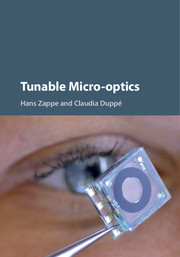Book contents
- Frontmatter
- Dedication
- Contents
- List of contributors
- List of acronyms
- Part I Introduction
- Part II Devices and materials
- 3 Soft-Matter Micro-optics
- 4 Tunable Reflective Optics
- 5 Tunable Liquid Lenses
- 6 Optofluidic Micro-shutters and Micro-irises
- 7 Solid Body Elastomeric Lenses
- 8 Spatially Tunable Polarization Devices
- 9 Aluminum Nitride and Diamond Membranes for Tunable Micro-optics
- 10 Piezoelectrically Actuated Tunable Microlenses
- Part III Systems and Applications
- Index
- References
8 - Spatially Tunable Polarization Devices
from Part II - Devices and materials
Published online by Cambridge University Press: 05 December 2015
- Frontmatter
- Dedication
- Contents
- List of contributors
- List of acronyms
- Part I Introduction
- Part II Devices and materials
- 3 Soft-Matter Micro-optics
- 4 Tunable Reflective Optics
- 5 Tunable Liquid Lenses
- 6 Optofluidic Micro-shutters and Micro-irises
- 7 Solid Body Elastomeric Lenses
- 8 Spatially Tunable Polarization Devices
- 9 Aluminum Nitride and Diamond Membranes for Tunable Micro-optics
- 10 Piezoelectrically Actuated Tunable Microlenses
- Part III Systems and Applications
- Index
- References
Summary
Introduction
Apart from the common properties of light, such as wavelength, intensity, phase and angular spectrum, polarization is becoming a decisive feature in many applications. Spatially controlled tunable polarization devices can be applied in a multitude of areas, such as wavefront control, microscopy, phase contrast techniques, interferometry, beam shaping, optical information storage and processing, holography, stray light methods and other optical measurement techniques.
Currently, tunable polarization devices are either electronically or optically addressed. Electronically addressed light modulators (EASLMs) such as liquid crystal displays (LCDs) or liquid crystal on silicon spatial light modulators (LCOS-SLMs) are electronically controlled pixelated devices with millions of pixels. They offer a high degree of freedom and can be easily reconfigured within milliseconds. Unfortunately, currently they have a limited pixel size of 3 μm (Bleha & Lei 2013), which restricts the resolution. Other technological restrictions such as electrode structure, gaps between pixels and addressing conductors may also lead to artefacts in the modulated beam. These artefacts are mainly pixel crosstalk and spurious diffraction orders (Lazarev et al. 2012). Therefore, many setups containing SLM use a carrier frequency and an aperture to separate the desired light pattern from spurious diffraction orders (Zwick et al. 2010). Due to the high carrier frequency, which restricts the working angle, this reduces the overall efficiency while adding additional components to the setup.
Optically addressed spatial light modulators (OASLMs) typically consist of a photosensitive and an electro-optic layer between conducting electrodes (Margerum et al. 1971). OASLMs need low optical addressing powers (100 μW/cm2), have a high resolution (feature size 2 μm), can be manufactured in large diameters (6 in. diameter) and allow high switching frequencies up to several kilo Hertz (Collings et al. 2003). They need high voltages for operation and are therefore difficult to miniaturize. Also, they need an external addressing system for pattern generation.
Optical addressing eliminates the artefacts of EASLMs. But OASLMs are rarely used today because of complicated, expensive and space consuming optical addressing systems. To overcome the disadvantages of current EASLM and OASLM devices, the goal of our approach is to implement an optically addressed tunable spatial polarization device with an integrated complex optical addressing system. We call this active micro-optic device for polarization control by its German acronym AMiPola.
For a high degree of freedom of the spatial polarization patterns the integrated optical addressing system should have several optical addressing channels.
- Type
- Chapter
- Information
- Tunable Micro-optics , pp. 197 - 218Publisher: Cambridge University PressPrint publication year: 2015



